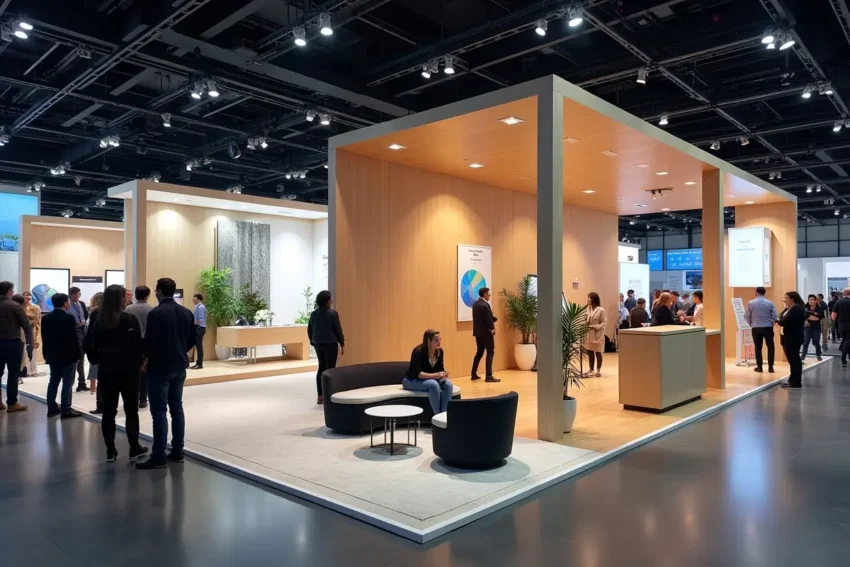Modular Design: The Future of Efficient Event Spaces

If you’ve ever walked into a trade show, you’ll know the feeling. Some stands grab you straight away — clever lighting, bold visuals, maybe even something unexpected that makes you stop in your tracks. Others? They fade into the background. What most people don’t see is the hidden design choice that makes the difference. Increasingly, that choice is modular.
Instead of massive one-off builds that cost a fortune and end up in a skip afterwards, more brands are turning to modular design. It’s flexible, it’s sustainable, and it lets you rethink how spaces are built without throwing away creativity. In a world where time, money and impact all matter, modular isn’t just a neat option — it’s fast becoming the standard.
Contents
Why Modular Design Has Become a Big Deal
Events are stressful. You’ve got short build times, limited space, and the pressure of standing out in a sea of competitors. Traditional stands can look stunning, but they come with baggage: high costs, long hours to put up and take down, and, let’s be honest, a mountain of waste once the show’s over.
Modular flips that on its head. Imagine a system you can reconfigure for Toronto one month and repurpose for London the next — same kit, totally different look. That adaptability is why more businesses are making the switch. It saves money, reduces waste, and gives brands breathing room to try something new without reinventing the wheel every time.
What Modular Brings to the Table
So what makes modular stand out? A few things really matter:
- Flexibility. You can build it big, small, wide, tall — whatever fits the space. One framework, endless layouts.
- Speed. Many systems click together tool-free. That means fewer headaches on build day and less reliance on big crews.
- Scalability. Got a small pop-up this week and a major expo next? Modular handles both without needing a new stand.
- Sustainability. This is huge. Instead of single-use materials that go straight to landfill, components are reused again and again.
- Cost savings. Over time, reusing parts means you’re not pouring money into one-off builds.
In short: modular gives you more control. You can focus on design and experience rather than battling logistics.
Why Events Need Adaptability
The events industry isn’t what it was ten years ago. Today, we’ve got hybrid conferences, travelling pop-ups, immersive activations, and brands chasing audiences all over the map. A rigid, one-and-done build just doesn’t cut it anymore.
Think about a company running a consumer expo in Toronto, a pop-up in Paris, and then a product launch in New York. With modular, they don’t need three different builds. They use the same system, reshaped and re-skinned each time. Branding stays consistent, costs stay sensible, and the design keeps feeling fresh.
Audiences are also savvier now. They expect interactive, Instagram-worthy experiences, and brands can’t roll out the same setup year after year. Modular makes it easier to switch graphics, update layouts, or add tech like LED walls and VR zones — without going back to square one.
A Practical Example: Team Tecna
To see how this works in real life, look at Team Tecna. Their T3 modular system is a good example of what’s possible when design meets practicality.
The T3 framework uses lightweight parts that lock together without tools. Graphics can be swapped in minutes, and the same kit can be transformed into endless new shapes. It’s quick to assemble, easy to transport, and doesn’t demand a warehouse full of parts every time an event comes around.
For companies, that means less stress and more freedom. Instead of worrying about how the stand will hold up, they can focus on what actually matters — drawing people in and giving them an experience to remember. Modular doesn’t limit creativity; it frees it up. And companies like Team Tecna are proving that efficiency and imagination don’t have to live on opposite sides of the table.
The Green Side of Modular
We can’t talk about the future of design without looking at sustainability. Events have a reputation for being wasteful. Once the lights go out, the carpets, signage, and even full structures often head to landfill. That’s not only bad optics, it’s bad for the planet.
Modular systems push things in a better direction. Because the components are built to be reused, far fewer materials end up wasted. Tool-free assembly often means lighter transport loads, which helps cut emissions. Combine that with eco-friendly graphics and energy-efficient lighting, and suddenly you’ve got an exhibition presence that looks good and feels responsible.
This matters more than ever. Many companies are working towards net-zero targets, and the partners they choose are expected to help them get there. In that sense, modular isn’t just a design choice — it’s a sustainability statement.
What’s Next for Modular Design?
So, where is all of this heading? The future looks exciting. We’re already seeing modular systems that integrate with large LED displays, touchscreens, and even augmented reality. Smart sensors are being used to track visitor flow, giving designers hard data to fine-tune layouts for maximum engagement.
The focus is shifting from “how does this stand look?” to “how does this space perform?” That’s where modular really shines — it gives you the framework to experiment, adapt, and evolve without breaking the bank or the planet.
Final Thoughts
Events will always be about connection: between people, between brands and audiences, between creativity and execution. Modular design ties those threads together. It gives businesses the chance to be bold without being wasteful, adaptable without losing identity, and efficient without sacrificing quality.
The message is pretty simple. The brands that thrive in the future will be the ones that stay flexible and sustainable while still pushing for impact. Modular design is set to play a big part in that future.



